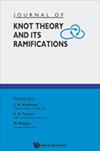用有限商判别某些属一结
IF 0.4
4区 数学
Q4 MATHEMATICS
引用次数: 2
摘要
利用$\pi_1(S^3\setminus-K)$的有限商,给出了区分$S^3$中的素结$K$与$S^3$中的每个其它结的一个判据。利用Baldwin-Sivek最近的工作,我们将该准则应用于双曲结$5_2$、$15n_{43522}$和每整数$n$的三股椒盐卷饼结$P(-3,3,2n+1)$。本文章由计算机程序翻译,如有差异,请以英文原文为准。
Distinguishing Some Genus One Knots Using Finite Quotients
We give a criterion for distinguishing a prime knot $K$ in $S^3$ from every other knot in $S^3$ using the finite quotients of $\pi_1(S^3\setminus K)$. Using recent work of Baldwin-Sivek, we apply this criterion to the hyperbolic knots $5_2$, $15n_{43522}$, and the three-strand pretzel knots $P(-3,3,2n+1)$ for every integer $n$.
求助全文
通过发布文献求助,成功后即可免费获取论文全文。
去求助
来源期刊
CiteScore
0.80
自引率
40.00%
发文量
127
审稿时长
4-8 weeks
期刊介绍:
This Journal is intended as a forum for new developments in knot theory, particularly developments that create connections between knot theory and other aspects of mathematics and natural science. Our stance is interdisciplinary due to the nature of the subject. Knot theory as a core mathematical discipline is subject to many forms of generalization (virtual knots and links, higher-dimensional knots, knots and links in other manifolds, non-spherical knots, recursive systems analogous to knotting). Knots live in a wider mathematical framework (classification of three and higher dimensional manifolds, statistical mechanics and quantum theory, quantum groups, combinatorics of Gauss codes, combinatorics, algorithms and computational complexity, category theory and categorification of topological and algebraic structures, algebraic topology, topological quantum field theories).
Papers that will be published include:
-new research in the theory of knots and links, and their applications;
-new research in related fields;
-tutorial and review papers.
With this Journal, we hope to serve well researchers in knot theory and related areas of topology, researchers using knot theory in their work, and scientists interested in becoming informed about current work in the theory of knots and its ramifications.

 求助内容:
求助内容: 应助结果提醒方式:
应助结果提醒方式:


